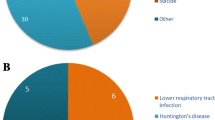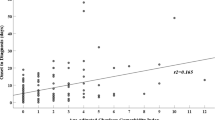Abstract
The objective of this study was to estimate probability of survival of Huntington’s disease (HD) patients in Serbia as a function of CAG repeat length and selected demographic variables. This follow-up study was carried out at the Institute of Neurology, Clinical Centre of Serbia, Belgrade, 1982–2004. The study group consisted of 112 HD patients. The significant inverse correlation was found between CAG repeat length and age at onset of HD (r = −0.732, P = 0.001) and age at death (r = −0.760, P = 0.001). The cumulative probabilities of survival in a five, ten, fifteen, and twenty-years’ period were 90.9, 63.2, 10.3 and 4.5%, respectively. Higher survival probabilities were registered in female patients, as well as in those with older age at onset and lower number of CAG repeat length (≤46). The Cox regression analysis showed that significantly poorer outcome of HD in our population was related to younger age at onset (HR-hazard ratio = 1.9; P = 0.047), and larger CAG numbers (HR = 2.4; P = 0.071). The female sex was statistically significantly associated with longer survival (HR = 0.4; P = 0.007). These data might be of some importance for further exploration of natural history and prognosis of HD.


Similar content being viewed by others
References
Aylward EH, Li Q, Stine OC, Ranen N, Sherr M, Barta PE, Bylsma FW, Pearlson GD, Ross CA. Longitudinal change in basal ganglia volume in patients with Huntington s disease. Neurology 1997;48:394–7.
Brandt J, Bylsma FW, Gross R, Szine OC, Ranen N, Ross CA. Trinucleotide repeat length and clinical progression in Huntington disease. Neurology 1996;46:527–31.
Cox DR. Regression models and life tables. J Royal Statist Soc 1972;34:187–220.
Culjkovic B, Stojkovic O, Vojvodic N, Svetel M, Rakic L, Romac S, Kostic VS. Correlation between triplet repeat expansion and computed tomography measures of caudate nuclei atrophy in Huntington’s disease. J Neurol 1999;246:1090–3.
Foroud T, Gray J, Ivashina J, Conneally M. Differences in duration of Huntington’s disease based on age at onset. J Neurol Neurosurg Psychiatry 1999;66:52–6.
Furtado S, Suchoerrsky O, Rewcastle B, Graham L, Klimek M, Garber A. Relationship between trinucleotide repeats and neuropathological changes in Huntington disease. Ann Nerurol 1996;39:132–6.
Huntington’s Disease Collaborative Research Group. A novel gene containing a trinucleotide repeat that is unstable in Huntington’s disease chromosomes. Cell 1993;72:971–83.
Illarioshkin SN, Igarashi S, Onodera O, Markova ED, Nikolskaya NN, Tanaka H, Chabrashwili TZ, Insorova NG, Endo K, Ivanova-Smoleskaya IA. Trinucleotide repeat length and rate of progression of Huntington’s disease. Ann Neurology 1994;36:630–5.
Kehoe P, Krawczak M, Harper PS, Owen MJ, Jones AL. Age at onset in Huntington disease: sex specific influence of apolipoprotein E genotype and normal CAG repeat length. J Med Genet 1999;36:108–11.
Koller WC, Barr A, Biary N. Estrogen treatment of dyskinetic disorders. Neurology 1982;32:547–9.
Kompoliti K. Estrogen and movement disorders. Clin Neuropharmacol 1999;22:318–26.
Mahant N, McCusker EA, Byth K, Graham S. Huntington’s disease. Clinical correlates of disability and progression. Neurology 2003;61:1085–92.
Markianos M, Panas M, Kalfakis N, Vassilopoulos D. Plasma testosterone in male patients with Huntington’s disease: relations to severity of illness and dementia. Ann Neurol 2005;57:520–5.
Mc Neil D. Epidemiological research methods. New York: John Wiley and Sons; 1996.
Persichetti F, Srinidhi J, Kanaley L, et al. Huntington’s disease CAG trinucleotide repeats in pathologically confirmed post-mortem brains. Neurobiol Dis 1994;1:159–66.
Roos RA, Hermans J, Vegter-van der Vlis M, van Ommen GJ, Bruyn GW. Duration of illness in Huntington’s disease is not related to age at onset. J Neurol Neurosurg Psychiatry 1993;56:98–100.
Rosenblatt A, Abbott MH, Gourley LM, Troncoso JC, Margolis RL, Brandt J, Ross CA. Predictors of neuropathological severity in 100 patients with Huntington’s disease. Ann Neurol 2003;54:488–93.
Snell RF, Mac Millan JC, Cheadle JP, Fenton I, Lazarou LP, Daves P, MacDonald ME, Gusella JF, Harper PS, Show DJ. Relationship between trinucleotid repeat expansion and phenotypic variation in Huntington s disease. Nat Genet 1993;4:393–7.
Shulman LM. Is there a connection between estrogen and Parkinson’s disease? Parkinsonism and Relat Disord 2002;8:288–95.
Wheelock VL, Tempkin T, Marder K, Nonce M, Myers RH, Zhao H, Kayson E, Orme C, Shoulson I. Huntington Study Group. Predictors of nursing home placement in Huntington disease. Neurology 2003;60:998–1001.
Author information
Authors and Affiliations
Corresponding author
Rights and permissions
About this article
Cite this article
Pekmezovic, T., Svetel, M., Maric, J. et al. Survival of Huntington’s disease patients in Serbia: longer survival in female patients. Eur J Epidemiol 22, 523–526 (2007). https://doi.org/10.1007/s10654-007-9157-7
Received:
Accepted:
Published:
Issue Date:
DOI: https://doi.org/10.1007/s10654-007-9157-7




